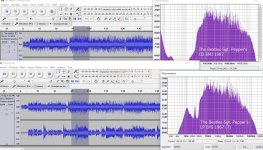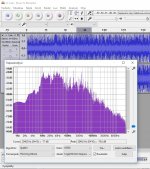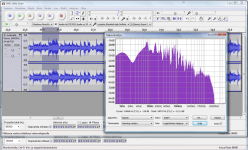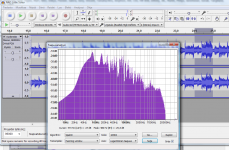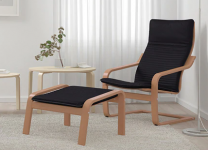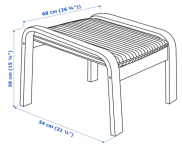Juhazi was quoted as saying "Obviously a dipole bass doesn't benefit from "pressurizing" like sealed bass, which happens below lowest room mode. Remember that this is different from boundary reinforcement, which happens already higher in frequency, and differently with dipole/monopole."
With this thread wrestling with low freq, I think we need an airing of the "pressuring" question (AKA "cabin boost"). Is there any difference in bass propagation with OB (perhaps related to pressurizing) and if so, why?
I'd sure like a good reply.
(While Juhazi is correct in what he says about pressurizing, I think there isn't much debate that in real home rooms* the effect is less than trivial. There are substantial effects due to boundary reflections which is a different matter all together.)
B.
* assuming the room isn't air-tight and made of concrete on 6 sides
With this thread wrestling with low freq, I think we need an airing of the "pressuring" question (AKA "cabin boost"). Is there any difference in bass propagation with OB (perhaps related to pressurizing) and if so, why?
I'd sure like a good reply.
(While Juhazi is correct in what he says about pressurizing, I think there isn't much debate that in real home rooms* the effect is less than trivial. There are substantial effects due to boundary reflections which is a different matter all together.)
B.
* assuming the room isn't air-tight and made of concrete on 6 sides
I would do this:
1. measure the response at both the front and the back openings, in the plane of the opening. This will capture the output (like a nearfield measurement) of only the driver, in the box, plus the resonance(s) of the tunnel of the H-frame, but not the dipole (far-field) response
2. Model the dipole response in the Edge by using a square baffle. For the length of each edge, use the front-to-back lenth of the H-frame plus about 1/3rd of the height. The driver should be in the center of the square baffle.
Add the two responses to get a rough model of the far-field response.
If you do not measure the front and back response as in (1) you will not capture the resonances, which cannot easily be modeled.
I will try this. I imagine when adding the two curves their phase should be inverted.
Previously these DP-15's were mounted on a shallow H-frame and I made ground plane measurements. That would be a huge undertaking and probably will not happen now. I practically broke my back assembling them.
Linkwitz designed this baffle arrangement for his Phoenix system but I've not been able to find any info on how he modeled it.
Thanks Juhazi and Charlie
I think this is what Juhazi meant:
I sort of browsed this thread and since part is concerned with low frequency reproduction I though these quotes for a paper by Blackman might be of interest. They are with regard to low frequency response of difference sources below the first mode.
"Below the first mode the sound pressure, especially for the monopole and the cardioid, first increases with the decreasing frequency, and then reaches a flat level. The increase can be explained by the fact that below the first mode the sound pressure gradually starts to obey the adiabatic equation of the state, which predicts the sound pressure to be proportional to the relative change in the enclosed [room] volume...The flattening of the response at the very lowest frequency results from the room losses; in realistic rooms the losses at very low frequencies are not frequency-independent. [This is with regard to the room transfer function which would be superimposed on the sources free field response.]
I will try this. I imagine when adding the two curves their phase should be inverted.
Just add the two curves (SPL only). The phase is already taken into account with the Edge model of the dipole.
This will be much easier than doing far-field measurements!
No, I showed that 20Hz is easily done with an H-frame, with an 18" subwoofer driver and D=30". See ---
HxWxD = 24x24x30" (60x60x93 cm) OK, so this is not huge yet!
My friend had tapped horn bass towers (sub) that were 2,5m high and roughly 80x80cm cross-section. Midbass was 2x18" box per side. They looked huge even in corners, but bass was good. Now he has miniaturized to Usher D3.
[url]https://www.youtube.com/watch?v=yc7sX2YLNG0
Last edited:
He's in the USA 😉HxWxD = 24x24x30" (60x60x93 cm) OK, so this is not huge yet!
HxWxD = 24x24x30" (60x60x93 cm) OK, so this is not huge yet!
Slight correction to your math...
30 inches = 75 cm (1m is approximately 40")
90cm long would be good, too!
Remember, you want to try and have the width:depth ratio of the front and back "tunnels" of the H-frame around 2:1 to keep the Q of the line resonance relatively low. My dims don't quite make it... The longer you make it the wider it should be as well.
I happen to use this size because I can find cheap precut sheet goods (e.g. particle board, MDF, plywood, etc) that are 2x4 feet, or sometimes even 2x2 feet, and these are handy for experimenting, etc.
That's the reason I am VERY interested in dipole bass, as low as I can go. The difference in leakage compared to a sealed sub is very real. With a nearfield dipole sub I can play >20dB louder than a farfield sealed sub would let me before neighbour complaints. In a medium/high density living arrangement dipole bass is a no brainer.
-you can also go with well-implemented Bass-shakers as an alternative (for bass and lower). (..dipole upper-bass lower-mid).
I just listened to Diana Krall's wonderful hifi-recordings, double bass is in big role. Even with modest neighbor-friendly spl bass sounds astonishingly right with just a 10"sealed+dsp, be upper parts dipole or not. Still, my partly dipole speakers sounded much better and natural than 3-way monopoles with similar 10" downfire bass. Of course one could use bigger speakers and nearfield etc. for dipole bass, but why make it so difficult? Room response, positioning is perhaps most important factor if the speaker is capable of going lower than 40Hz.
I understand and identify that certain amount of perfectionism is built-in in diy-hifi, like in mountain-climbing. No offense to Charlie, Nelson et.al. ! Now I try to keep sordino plugged in for a while.
ps. Synthetic bass like from Yello or Laurie Anderson are too easy to reproduce, you don't have reference to how it should sound! And I don't like them either. This is a nice pick for acid test, lots of power below 40Hz, even down to 10 (at least on European CD) - The Road To Escondido (U.S. Version) by J.J. Cale on Spotify
I understand and identify that certain amount of perfectionism is built-in in diy-hifi, like in mountain-climbing. No offense to Charlie, Nelson et.al. ! Now I try to keep sordino plugged in for a while.
ps. Synthetic bass like from Yello or Laurie Anderson are too easy to reproduce, you don't have reference to how it should sound! And I don't like them either. This is a nice pick for acid test, lots of power below 40Hz, even down to 10 (at least on European CD) - The Road To Escondido (U.S. Version) by J.J. Cale on Spotify
Last edited:
You know, after all the comments, I think I will build an upcoming project with the option of a monopole sub. This was to be a 3-way nude speaker from 100Hz and up, and then H-frames below. But I realized I can easily place a closed box sub directly below the nude woofer of the 3-way and create a cardioid pattern in the crossover region, with monopole below, and dipole above. It might be that in smaller spaces the monopole low end would be better, and in larger spaces the dipole (H-frame) low end would be better. It would be an interesting experiment.
The real question is over what frequency range should I operate the system in cardioid. For practical reasons, it can't be below about 80Hz but it could be from 80-160Hz potentially.
I can still build the H-frame sub(s) and then I can switch them in and out easily (I use DSP crossovers) and see if I prefer one or the other.
The real question is over what frequency range should I operate the system in cardioid. For practical reasons, it can't be below about 80Hz but it could be from 80-160Hz potentially.
I can still build the H-frame sub(s) and then I can switch them in and out easily (I use DSP crossovers) and see if I prefer one or the other.
Still, one funny thing about bass. I have digitized many of my old vinyl LPs with EAC and Audacity. Sadly my gear is not high-end and has lots of rumble and cartridge resonance - I use highpass filters to cut it out, like 24dB/oct at 30Hz. But that easily removes the "vinyl sound" too, there is lots of ambience in low bass, even it is artefact for the most! That much low bass would be dangerous for typical BR 2-way hifi-speakers, but in old days most people had closed box speakers and all amplifiers had low-cut (rumble) filters.
Modern digital recording-producing process is often misused and bass below 40Hz is rare species. With speakers capable of sub-40Hz and without reflex will reveal these huge differences in distributed recodings easily.
Modern digital recording-producing process is often misused and bass below 40Hz is rare species. With speakers capable of sub-40Hz and without reflex will reveal these huge differences in distributed recodings easily.
Attachments
Last edited:
For sweet-spot-only duty in a small room a near-field OB mono-bass (15"...21" nude is nice for this) mounted behind the seat is also an option and if you couple it to the chair mechanically it doubles up as a shaker (but then maybe better float the chair on dampers). Should give serious impression of very deep bass even down below 20Hz.
I've personally used one 18" nude behind my seat for quite some time (no coupling, though) and it worked really well, lot's of deep loud bass and neighbors were happy.
I've personally used one 18" nude behind my seat for quite some time (no coupling, though) and it worked really well, lot's of deep loud bass and neighbors were happy.
Interesting 🙂 I do not know if it would work regarding distance and orientation (tilting), but a friend of mine has the Poäng with the footstool. The front opening (listeners side) is about 30x60cm: one could fit 2x 12"!
Attachments
I've personally used one 18" nude behind my seat for quite some time (no coupling, though) and it worked really well, lot's of deep loud bass and neighbors were happy.
and your crossover point was?
80Hz LR4 makes a sub behind the listening position difficult to localise as long as it is low in distortion and spurious noises.
Just adding: I very much appreciate the idea of the sub behind the chair and any further information is very welcome! With the Poang footstool I am just thinking about combining it with an existing - and valuable 🙂 - piece of furniture.
Some of that would be filtered out be the upholstery 🙂80Hz LR4 makes a sub behind the listening position difficult to localise as long as it is low in distortion and spurious noises.
IIRC I used 100Hz linear phase 1st order Neville-Thiele as provided by the Acourate Toolbox for DSP XOver and room correction package. I actually happened to have an IKEA Poang and the 18" 30cm behind the stool was located at chest-height firing 20° or so upwards as simply established by suspending the driver from two adjacent mounting holes with ropes. From that angle our sensitivity to noise etc is lowest, it seems.
In spite of this, say rather crude, quick&dirty setup I found the result was stunning. Headphone-like bass... but that was a weak point long-term, for most of the music I listen to I prefer the "monopole slam" in the low bass. Plus form-factor and aesthetic reasons made me gave up this route.
In spite of this, say rather crude, quick&dirty setup I found the result was stunning. Headphone-like bass... but that was a weak point long-term, for most of the music I listen to I prefer the "monopole slam" in the low bass. Plus form-factor and aesthetic reasons made me gave up this route.
- Home
- Loudspeakers
- Multi-Way
- In Pursuit of a 20-20k Dipole Loudspeaker
